DESIGNING A HOUSE ~ DESIGNING A START-UP COMPANY
Is a Start-up anything at all like a residential design project? Analogies again? Yes, and I think I can make this one work….
This is some of what I learned from my experience in the Start-up universe, which has influenced INCLINEDESIGN Architectural and Interior Design Solutions, and made it successful.
BUILD A GREAT TEAM
That’s a no-brainer, as our success as designers is so totally dependent on the team we put together; whether to renovate or build anew.
The contractor or site manager can make or break a project. Some clients insist we do their site management; more stress, but more control.
The subs or trades are what make everything successful, by implementing the design correctly, and working together. By working together I don’t just mean just “getting along”, but anticipating the job sequence. When a trade doesn’t anticipate or understand job sequence, the drywall gets installed over where the electrical outlets go (it happens…). However, today with email or SMS, we can eliminate much of this, as the drywaller can be told that the electrician is next up, so review the plans online;….. everyone can be informed on a need-to-know basis what, when, and who is required.
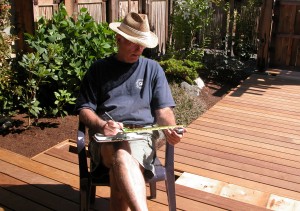
…….please, just double check the measurement against the plans….
A blog about a specific project is ideal for client updates and can both acknowledge and inspire the team members, and showcase the project as it evolves, giving each participant a sense of their contribution to the whole. My design partner, James is blogging about a Riva speedboat restoration he is carrying out, and after only five posts has already created quite a community around the project.
When building a Start-up team in today’s global economy, I believe it IS important to bring together diverse languages and cultures. Though we don’t set out to do this specifically in a residential project, it just seems to happen, and can add talent & expertise to the mix.
WORK SMART – THE 6 P’S
Prior Planning Prevents Piss Poor Performance
Planning, Planning, Planning & more Planning. Sounds boring, but actually it is fun (sort of….).
We create a Design Philosophy for each project, collaborating with our clients to insure amongst other things, consistency of design, which we do well. Collaboration is key.
We also create a Road Map for each project; if you don’t know where you are going you can’t get there! With good planning, we can pick a route that is the shortest from A to Z, even though it may go via G & S, and be running several tracks at a time. This means several trades working simultaneously on different parts of a project; this can be done efficiently, and work very well, with impeccable planning & scheduling.

This steel window took 7 of the crew to lift; yet it was installed easily by the contractor alone. At the same time the crew closed in the roof. That’s working SMART.
Today we no longer lay out a one-dimensional, sequential plan; things have to happen so much faster, whether it is bringing a product to market or a residence ready for occupancy.
SOLID FOUNDATIONS, & INFRASTRUCTURE THAT WORKS
Everyone knows about solid foundations when building a house: the foundation supports the structure, the structure supports the roof.
The Infrastructure itself gets less attention, because it’s not usually visible; out of sight = out of mind. This is something I focus on, as it is what makes everything “work” in a house. I review the accuracy of all plumbing, heating, A/C, wiring, lighting, and switching plans, as well as the multimedia, computer, phone, and security networks. I run a check to see if the layouts are compatible with our client’s lifestyle and with each other; especially if several other specialists have been brought in to design parts of the infrastructure.
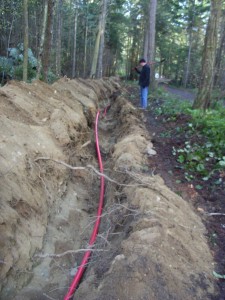
…..ooops they forgot to lay the phone line with the electrical conduit.

Documenting all hidden infrastructure, just in case……and yes, Copper is still used in some projects.
So what is the infrastructure in a house analogous to in a Start-up? My question is going to take someone like designer Mellissa Galt to answer succinctly…..
BE FLEXIBLE. EVEN BETTER; BE ANTICIPATORY
This involves quick thinking when something doesn’t work, and maybe even quicker thinking when it works better than expected It means cut your losses sooner rather than later. This can be painful in either a start-up or a design project, as it will appear you are moving backwards! Not easy for the entrepreneur CEO to tell the team to change direction, or for the designer to tell the crew and the client we have to rip it out and start over! The way I’ve leaned to deal with this is; don’t perceive plans as set forever in stone, instead they are guidelines, which can be modified, changed or improved if required, to move a project forward to a successful conclusion.
Residential projects can be an emotional roller coaster just the way a start-up is, so the key is not to be overly discouraged when things go off track temporarily.
When changing direction, there usually has been a mistake, so part of this strategy of flexibility is being flex enough to spot mistakes (early would be nice….), or listen carefully and with an open mind when someone else does. And then learn from them.
My biggest mistake when designing my first companies was doing the “perfect product introduction”, and thinking I had a company. Thank you Bob Goff, mentor & founder of the Sierra Angels, for pointing out the shortcomings of this plan all those years ago. In residential design it’s all too easy to get fixated on just the “fabulous” design, and forget the rest; implementation, infrastructure; those things.
FLOW CASH
I have seen some gorgeous cost spreadsheets, almost an art form, generated by both start-ups and residential construction companies. Unfortunately, they often have no relationship to reality. Cost projections on a project should be guidelines; of course this does not mean you should not cost things out as accurately as possible.
When doing standard construction there is not much challenge to get the costs right, especially if you are familiar with going rates of trades and materials.
However, the challenge is when you do one-of-a-kind design, or add innovative design details. You don’t have a benchmark, and often the actual implementation gives you the only “real” cost, and can be several times higher then what you anticipated. (you’ve all heard of “time & materials”, right?)
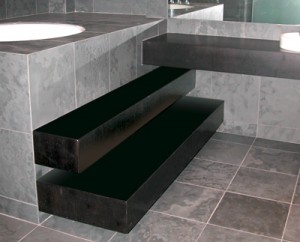
Floating steps & vanity with no visible means of support. Expensive but worth it! (Skyloft during construction)
Contingencies are all very well for situations like this, but no substitute for good communication with the client. The client who wants “different” needs to understand the implications! Part of our job.
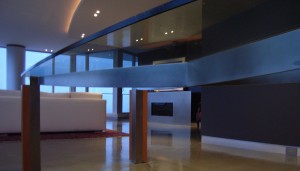
We are passionate about the opportunity of designing some or all of the furniture as part of a residential project.
Is there any similarity of accountability between us as designers and our clients, and a start-up company with their angel or VC?
MANAGE TIME
In mentoring, this is one of the most challenging aspects I encounter. Yes, you can do 80 hours work in a 40 hour work week, and sleep as well. It’s called time management and realistic scheduling. Some “technically savvy” construction companies with elaborate computer programs love to create colorful and complex timelines to present to the client. Seldom have I seen one that is realistic about scheduling…..
Sometime ago I went with a client to meet with the contractor, as the job was already 9 months late (I came late to the mix unfortunately). Occupancy was assured for “the end of March”. I looked at the colorful timeline, laughed, and pointed out (to everyone around the meeting table) that I would estimate the end of June if everything went right, and nothing had so far….that was double by my estimate. Shortly after, contractors were changed (not an easy decision but without it, profitable exit strategy would not have been an option: the current path made moving in ever unlikely, and selling the house to recoup investment even less so) and my client moved in on – you guessed it – June 20.
How does this all relate to how INCLINEDESIGN manage their business? We cost and schedule very efficiently, certainly, however we fail in so far as there is a certain amount of time we invest in any project for which we don’t get paid!
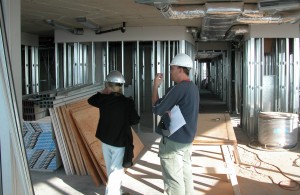
There is no substitute for checking up with the site manager in person. Hard hat, replaces the red hat.
MULTIFACETED
As part of my online profile, I bill myself as a multi-faceted entrepreneur. With both James and myself the principals of INCLINEDESIGN, our varied expertise really pays off for our clients.
In another career I wrote, produced, and filmed environmental documentaries for TV; filming on remote locations for many months at a time. When asked by interviewers what I did, my answer was “I write, edit, film, edit, produce, edit, and deliver unprocessed film, and clean the maggots from the campsite cooler”. That’s just what you have to do in a small company, and especially a start-up (editing, and most often cleaning up).
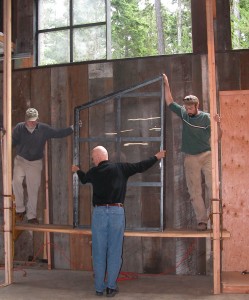
This designer can do just about anything….and if needed gives the extra hand…..or two.
MARKETING
In our design business we are fortunate that when a client contacts us to do their residential design, they are usually already sold on us to do their project. However, once a project starts and we are intensively collaborating with our client, we are marketing ourselves subtly but continuously, using all the communication and presentation skills we developed while in the corporate space. I commented on this after Laura Schaub’s post about Design Drawing Diversity.
Our clients are very successful and busy individuals, who have selected us for being self-motivated, understanding their design criteria and implementing fast. One of my favorite site managers instructed me to present only one option (“remember, the client already loves your design”), and only have Plan B ready in case. We only had to execute 3 plan B’s on that project; a frame-up renovation of 6000sf.
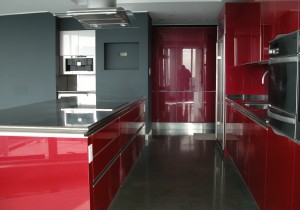
When there is a trust between designer and client ……………..design happens.
It would seem, in terms of the analogy at hand, we are (or appear to be) somewhat less focused on sales and marketing then we should be, and why do you think that is?
INNOVATE
If you don’t have a product or service that sets you apart, can you really be successful? Ask any of our clients, we are available 24/7. And because they know this and know that when they need an answer they get it, we have never felt taken-advantage of. We understand the kind of 24/7 global business climate our clients operate in.
Our clients always expect us to come up with designs to surprise them. New ideas they would otherwise never have thought of.
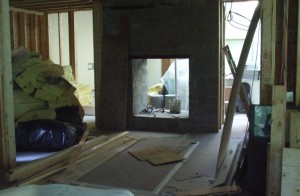
Client loved my suggestion of creating a VERY large see through fireplace between the living room & kitchen.
Most of our design tends to the Minimal – where less is more. So why does less, cost more? James says this is because simplicity is elegant, and elegant is hard to achieve, and he should know! And with our focus on “going green”, that may cost more upfront, while we hope saving over the long term.
INVESTMENT
Do our clients believe our residential design is a good investment?
Our clients are investing in their lifestyle when they retain us, however that “resale” word is always lurking in the back of everyone’s mind….
I measure success by a client telling me….. “your design really works for me, for our family, for entertaining, team cooking” ……. “It’s just the way you said it would be” …… “I keep discovering new things about your design” ….. “everyday a new discovery, a new experience”…..
And when the house sells for more than anyone anticipated, that feels good too…to everyone.
It has been an interesting excursion for the last 5 years into high-end residential design, though it is really nothing new, and has been a second career track for me on and off for over 25 years. My design partner James, studied architecture, then changed direction to product design & advertising, and then followed a career on both the agency and the corporate side. He always kept one hand in architectural design though, designing restaurants and commercial spaces, whenever a project was simply irresistible.
What added knowledge, expertise and skill-sets do you think we have gained from our recent experiences designing high-end residences, which may be transportable to designing a start-up company?
CASUDI













January 19th, 2010 at 7:28 am
Great post, would also be awesome as a series so it is bitesize in it’s depth and richness! Together we all go farther and leveraging technology to make the team stronger is essential as is regular, frequent, and consistent communication by all parties. A blog as a way to track a project and keep excitement high is an outstanding recommendation!
January 19th, 2010 at 9:48 am
Excellent points, Casudi. I like the way you tie everything together.
I might offer that it’s important to have goals or deliverables in place prior to planning. Otherwise, it can be easy to spend so much time planning that you never actually execute! I’m reminded of a scene in the movie Office Space, where Peter Gibbons is meeting with “the Bobs” in the conference room. Behind him, on the white board, is an elaborate flow chart titled “Planning to Plan.” It takes up the entire white board! Just goes to show what can happen when there isn’t enough direction behind the plans.
In construction (and other industries), I can understand the need to do a thorough amount of planning up front in order to hit the ground running as a lean animal on Day One, but where there are opportunities for fixed costs which will not change (or change sufficiently to negatively impact the project as a whole), there is merit to getting a broad strokes plan in place – a big picture, general idea if you will – and then just going for it.
What was that anthropology book called? “Hard Light, Soft Focus?”
We are most successful when we learn from our failures, but it is impossible to predict every failure, much to the chagrin of the actuaries and statisticians of the world. 😉 The road is dark, but with headlights and a compass, you can find your way. The route might not be as smooth and straight as you’d imagined, but the act of making progress and overcoming obstacles as they come along refines the original idea. If the final goal is rigid and fixed, then it must remain a beacon to guide whatever path might be tread to that end, but in cases where the goal is a general direction, the journey may never end, and we may find ourselves trending to one side of the beam or the other, depending on the circumstances.
Foundation and infrastructure remain critical to any project, though. Even with the organic, general direction project, without a solid foundation to provide support for sound decision making, things will go astray. Likewise with infrastructure. These are the systems which support decisions made upon the foundation. Foundation gives a frame of reference, infrastructure provides a means to deliver the faculties required to act on those decisions consistently.
Now, if you wouldn’t mind. Kindly point out to James that Perlita Too is nowhere near that electrical conduit in the woods pictured above. (Unless his to-supercharge-or-not-to-supercharge dilemma has driven him mad and he now plans to convert her into a tree house. Which would be equally cool in my book.)
Cheers!
January 19th, 2010 at 10:34 am
A beautiful project. Green needn’t be expensive, of course: this is a luxury home. But the design elements seem very thoughtful, and the higher front-end price will be rewarded with lower long-term costs.
I’m smitten by the rainwater catchment and see-through fireplace. 😉
January 19th, 2010 at 11:05 am
Great post, Caroline. I love how you wove everything together.
January 19th, 2010 at 9:23 pm
Your comments greatly appreciated Melissa, Brian, Chris, and Debra. Thanks!
Melissa, great suggestion about the serialized version ~ and I must admit that focusing on each section in depth would really be a much better format for this information. However, with the eclectic focus of Inclined To Design, I am not sure I would do it justice. This is perhaps more your bag, and why I really can identify with how you, a successful designer, has created your Prosper by Design identity. It’s interesting that recently I have mentioned the blog per project idea quite often, and found it has been extremely well received. It was Danny Brown who commented that what I am doing is actually creating a community around a project, with a project-focused blog. That’s something for a future post, ‘project mini-communities’.
Brian, I think most of our project pre-planning goals would be set during the collaboration with the client, creating the design philosophy for the residence. This discussion covers very generally how the client wants their home to look and feel; how it will affect their lifestyle, and what are their design preferences (what do they like most about our design?). The goals are further defined when the road map (how to get there) is worked out. Occupancy is a very definitive goal, and yet sometimes this gets lost, and project takes forever, or never gets done. Of course, this never happens when we’re involved 🙂
Your comment about infrastructure is perfect; I could not have said it better:”Foundation and infrastructure remain critical to any project, though. Even with the organic, general direction project, without a solid foundation to provide support for sound decision making, things will go astray. Likewise with infrastructure. These are the systems which support decisions made upon the foundation. Foundation gives a frame of reference, infrastructure provides a means to deliver the faculties required to act on those decisions consistently”. Brilliant!
Chris, I have read what you write about ‘minimal,’ and simplifying “life” with less stuff. You would laugh at how often I go through the same scenario, with clients who retain us to design simple, clean, minimal design; and then want to move in with a lifetime of accumulated stuff, which they don’t use, really don’t need, yet can’t get rid of, and compromises the design they paid so much to realize! BTW, the images in my post were from four different projects; however clients & friends have often said that our projects have a definite INCLINEDESIGN ‘fingerprint’ on them, whether they are Northwest Fusion, Contemporary, or Minimalist. And anyway, all the elements could very well have been from one residence, as they do all fit together.
Rainwater catchment and storage is one of my passions. The concept design demonstrates that a water storage tank could be an integral part of the design from the beginning, & not an afterthought, as is so often the case (engineering the structure above the tank was a challenge). The “out house” used to be a stand alone in the back yard, so how did it gain acceptance as an integral part of the interior infrastructure of a house? The same acceptance of rain catchment systems needs to happen, though not necessarily for inside the house 🙂
January 20th, 2010 at 8:02 am
I said something brilliant? Wo0t! 😀
I love your rainwater collection efforts, Casudi. On the subject of rain, here’s something you might find novel to think about. We got the mother of all rain storms here in Phoenix yesterday. I mean, the light rain started around 3PM and it poured until about 10PM. My backyard was a lake and my dog hid in the garage all night.
This morning, on the news, they said we got 0.91″ of rain yesterday.
That brings the total – for the year – up to 0.98″.
I know it’s still just January, but I think that, aside from the storm yesterday, I’ve seen about 60 minutes of light rain in the last 12 months. And that was over the course of about five occasions!
We should be banking on rain here in Phoenix. We should also be storing up solar energy, but these are topics for another day…
January 20th, 2010 at 9:11 am
As you probably know, I’m readying a new site called The Minimalist Century. The basic premise is this: We’re really not going to have much choice on embracing minimalism — the demands of the coming century will make it happen, whether we like it or not.
Which speaks to your question of how we’ll eventually mainstream things such as rainwater catchment. Water management is going to become a hot-button issue, and I’m convinced we’ll see mandates in this area, beginning with areas most pressed to stretch their supplies. But it’s in everyone’s interest that we adopt better practice as early as possible.
People will adopt greener technologies as they see it benefits them. Highlighting projects like yours and developing long-term case studies of cost savings and lifestyle enhancement are positive steps in this direction. It’s the kind of stuff we’ll be doing on The Minimalist Century.
As you mention, outhouses were once the norm. The same with indoor baths — these weren’t commonly available until well after the turn of the 20th century. They became more popular as the health benefits of personal sanitation became known. It was an important social movement.
Initially, what we would consider modern plumbing was something of a status symbol. This led to broader public expectations and the political resolve to invest in infrastructure. Rain catchment, high-efficiency appliance and fixtures, and home energy generation will all happen in the same way: pilot projects, publicity, and public investment.
It’s how the future happens.
January 20th, 2010 at 9:18 am
Caroline, excellent observations and teaching points! I have a brother who is a contractor and nodded my head to the many of the pitfalls you pointed out. My brother is very much a planner and masterful at organization and efficiency. He too has laughed at pretty sheets with no basis in reality. In my own business, I emphasize many of these values – personalized planning being at the top. It is quite frankly stupid to set yourself and client up for failure. Plan, have a contingency plan, prepare for success and unexpected blips and be realistic with your client and yourself.
January 20th, 2010 at 6:21 pm
Your suggestion to anticipate change resonates well with the start-up analogy. Be defined by your response to problems, not the problems themselves….and when planning, do so with a desire for success in mind, not a fear of failure!
January 20th, 2010 at 9:29 pm
Brian; yes, you should be banking rain, and yes, you can have rain catchment in the desert. Did you know there is a certain amount (more than you might think) of water collection simply from condensation. With xeriscape (featuring drought-resistant planting) and the water you collect, you can lower your water useage measurably (unless you are into washing cars! OBTW: rainwater doesn’t spot). Now if everyone in your neighborhood were to commit to collecting rain, and then everyone in Arizona and Nevada….get the picture? As always, your comments really get me to thinking; you’re great at that!
Chris, I am really interested in continuing the dialog with you about “marketing minimalism,” or differently put, “marketing embracing minimalism,” either here or in another venue. I do this obviously with my residential design clients; I mentor Rainbank.info, a start up business I created for a fellow islander; I am involved with Bank-On-Rain at the lower end, designing grassroots water solutions for remote locations of the planet. It comes down to converting people to thinking “indoor plumbing” rather than ‘outhouse’ at the upper end, and thinking “a better life” in the third world scenario, where life has not changed much in hundreds, even thousands of years. Thanks for the dialog, I really appreciate it.
Karen, great to meet you on #brandchat today. You summarized in just about three lines, what it took me (I hate to admit it!) over 2000 words, to write. Excellent summary in every respect. Thanks for commenting on Inclined To Design, we are really pleased to have you as part of our community.
Darnoc, thanks for adding the “desire for success” ingredient into the Start-up scenario. When I see the flip side: “fear of failure” in anyone I mentor, I know that my chance of success of helping that particular entrepreneur is greatly reduced. And I might add; problems should be fun, defining them and then solving even more fun……add into that the “desire for success” and you are winning all the time. Thanks Alex, for your contribution.
January 21st, 2010 at 10:54 am
You’re right about the rainwater collection, Casudi. It’s something we ought to be considering right now. Chris mentioned that the best route to adoption of such technology is likely to show people how such things can benefit them directly. I like to think, taking that a step further, that if we decide to wait for our duly elected “representatives” to grow bored with their incessant bi-partisan power-grubbing, we will never see necessary change.
It is up to us to implement ideas like these and to invite our neighbors over to see how they, too, would realize value from them. We could wait and wait and wait forever for the politicians to plan rainwater catchments across the southwest (no doubt to compliment the raft of solar arrays), or we could look to ways to do it ourselves.
I really like this idea. I know we’re on a tangent, but I wonder if there isn’t more information on DIY catchment considerations on the BankOnRain site. If there isn’t, perhaps there could be? Not everyone wants a row of blue barrels and PVC cluttering their yard, so how might one who is (wait for it) inclined to design implement smaller scale systems which are neither expensive, nor ugly?
Make it look good. Make it easy. Make it valuable. Got viral?
January 27th, 2010 at 2:00 pm
I truly enjoy this blog, and especially this post which echos my professional take on things (I am a global marketing consultant) and it also echos my personal experience (having a house designed)
I would like to add a magic number seven(7) to the P list, P=“Positioning” . I consider this one of the most important marketing elements. In any project, whether a house, a new company or a product introduction, clear positioning before planning is crucial for success; clear global positioning can provide a realistic picture of who the target audience is and enable one to develop a thorough workable plan for deliverables. In the past 10 years many large multinational companies entered the Asia market, especially China and Japan without clear positioning and an understanding of the cultural differences in the market, causing failure and the loss of millions & millions of dollars.
From my personal experience, positioning a house in its location on the ground would seem to be equally or more important. Feng Shui is often the prime consideration for this, however with emphasis on energy savings there have to be a whole list of environmental considerations in how a house should be positioned. In colder areas you would want to be exposed to more sunlight, and in areas where you want to keep your house cool you would want to locate your house just the opposite.
You make reference to the “resale” word lurking in the background, so this makes me think that in a renovation the design and related implementation costs do require clear positioning based on the final price range and target audience (the next buyer) as well as all the planning you cover in your post. The challenge of finding a designer who can deliver design and investment value would be an extremely crucial part of any renovation or build from scratch plan. I have to admit that INCLINEDESIGN has done an outstanding job for me combining lifestyle enjoyment and investment success 🙂 Thank you.
January 30th, 2010 at 11:53 am
Brian, I am always thinking of ways to market a lifestyle which considers the environment. As far as “good looking” rainwater storage solutions for retrofitting into suburban America, there really is nothing that fits the bill at a reasonable cost per gallon. Check out what I created for the WA state Department of Ecology website http://www.ecy.wa.gov/programs/wr/hq/rwh.html (right hand column select slideshow); it shows some solutions in the San Juan Islands.
Although these would not meet your retrofit criteria, I do have an idea for a product design which I could demo to you on an image of your house (using photoshop); back & sides please;-). BTW ~The Bank-On-Rain website and focus is for developing (I don’t like the term third world) countries, and the repurposed fish totes would not be acceptable to you or your neighbours..! FYI we are moving forward with two projects in Rwanda, including a girls school, which will collect & store rainwater for a dormitory, and be used for teaching the girls; anticipating they will bring the practical knowledge of rain collection & storage back to their villages. We need to create this same kind of viral dissemination in your neighborhood:-) Let’s continue this discussion.
Aliwan, thank you for a great comment, and for the addition of “Positioning” to my post. We have used Feng Shui concepts in our planning (and I know just enough to impress everyone!), and we consult with a Feng Shui Master or specialist when a client requires it. What is really interesting is so often Feng Shui dictates a design layout (positioning) I am already marketing to a client. Often I find the colors I select for a particular client & house are the ones the Feng Shui expert says are the most appropriate.
Designing for resale as such is not my choice usually; designing for added value is more my focus, though the latter can really increase the resale value. People can get so fixated on resale that they delete much of the enjoyment value they might have while they live in a house. Many times in the past when I used to help real estate agents by helping their clients do a quick fix prior to selling, they would say “if only I had done this before and had years of enjoyment from it, instead of fixing it up for someone else!” Sad but true. I would really enjoy collaborating with you again, either on a house or a start-up company!!
February 15th, 2010 at 11:51 pm
A beautiful project. Green needn't be expensive, of course: this is a luxury home. But the design elements seem very thoughtful, and the higher front-end price will be rewarded with lower long-term costs.
I'm smitten by the rainwater catchment and see-through fireplace. 😉
March 12th, 2011 at 5:18 pm
How should a person with extremely diverse professional skills brand+market himself?…
It is important to brand yourself as “multi-faceted” but not to the extent of being a “Jack of all trades and a master of none.” When showcasing the various diverse areas you are proficient in, it is important to draw parallels between your basic s…
January 13th, 2012 at 4:02 pm
[…] to do it in one shot, yet our goal remains to be totally design-consistent. Check out my post on design planning, and also see how it compares to starting a […]
January 29th, 2012 at 5:51 pm
Nice advice: “Work Smart – The 6P’s”.
September 20th, 2013 at 3:37 am
[…] designing a house or a company, your team ultimately makes you successful. In some projects there can be as many as 15 or 20 […]